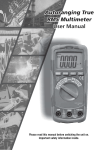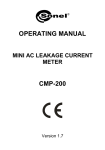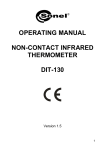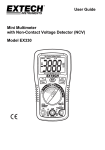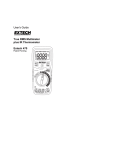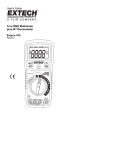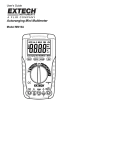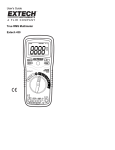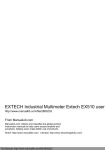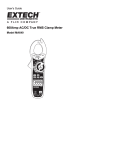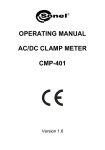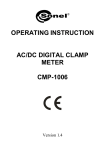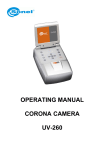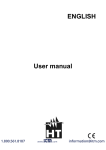Download User Manuals
Transcript
OPERATING MANUAL AUTORANGING MULTIMETER CMM-10 Version 1.7 Multimeter CMM-10 has been designed for the purpose of measurements of AC/DC voltage, AC/DC current, resistance, capacitance, frequency, duty cycle, temperature and also for testing diodes and continuity. The most important features of CMM-10 are: • • • • • • 2 automatic or manual regulation of the measurement range, DATA HOLD function, which facilitates readings of measurements in the case of insufficient lighting or in inaccessible places, REL function, which allows you to make measurements relative to a stored reference value, circuit continuity sound signalling, the function of automatic switching of the meter into the standby mode in order to prolong the durability of batteries, 3 7/8 digits display (5000 counts). 1 INTRODUCTION ................................................... 5 2 SAFETY ................................................................... 6 3 PREPARATION OF THE METER FOR OPERATION .................................................................... 7 4 FUNCTIONAL DESCRIPTION............................ 9 4.1 MEASUREMENT SOCKETS AND ELEMENTS OF SELECTION OF THE MEASUREMENT FUNCTION....................................................................9 4.1.1 Sockets ..............................................................................10 4.1.2 Elements of selection of the measurement function...........10 4.2 LCD DISPLAY ...........................................................................11 4.3 TEST LEADS ..............................................................................11 5 INTERNATIONAL SAFETY SYMBOLS.......... 12 6 MEASUREMENTS............................................... 12 6.1 6.2 6.3 6.4 6.5 6.6 6.7 6.8 6.9 6.10 7 DC VOLTAGE MEASUREMENTS .................................................12 AC VOLTAGE MEASUREMENTS .................................................13 DC CURRENT MEASUREMENTS .................................................14 AC CURRENT MEASUREMENTS .................................................15 RESISTANCE MEASUREMENTS ..................................................16 CONTINUITY MEASUREMENTS .................................................16 DIODE MEASUREMENTS ...........................................................17 CAPACITANCE MEASUREMENTS ...............................................18 FREQUENCY OR % DUTY CYCLE MEASUREMENTS ....................18 TEMPERATURE MEASUREMENTS ..............................................18 SPECIAL FUNCTIONS ....................................... 19 7.1 7.2 7.3 7.4 AUTORANGING/MANUAL RANGE SELECTION ............................19 RELATIVE MODE.......................................................................19 DATA HOLD FUNCTION .........................................................20 DISPLAY BACKLIGHT ................................................................20 8 BATTERY REPLACEMENT.............................. 20 9 THE FUSES REPLACEMENT ........................... 22 10 CLEANING AND MAINTENANCE .................. 22 11 STORAGE ............................................................. 23 3 12 DISMANTLING AND UTILIZATION .............. 24 13 ATTACHMENTS.................................................. 24 13.1 TECHNICAL DATA .....................................................................24 13.2 STANDARD EQUIPMENT ............................................................27 13.3 MANUFACTURER ......................................................................27 4 1 Introduction The CMM-10 meter is a modern, high-quality measuring device, which is easy and safe to use. Please acquaint yourself with the present manual in order to avoid measuring errors and prevent possible problems related to operation of the meter. In the present manual we apply three kinds of warnings. These are texts in frames, which describe possible dangers both for the user and the meter itself. The messages starting from the word ‘WARNING:’ describe situations which imply a risk for life or health should the recommendations presented in the present manual not be observed. The word ‘CAUTION!’ introduces a description of a situation where non-observance of the recommendations presented in the present manual may imply damage for the meter. Indications of possible problems are preceded by the word ‘Note:’. WARNING: The purpose of the CMM-10 meter is to realise measurements of AC/DC voltage, AC/DC current, resistance, capacitance, frequency, duty cycle, diode test, continuity and temperature. Using the meter in a manner which does not comply with the recommendations specified in the present manual may lead to its damage and constitutes a source of a serious risk for the user. WARNING: The CMM-10 meter may be operated solely by qualified and properly authorised personnel for work at electric installations. Using the meter by unauthorised personnel may lead to its damage and constitutes a source of a serious risk for the user. 5 WARNING: Before using the instrument acquaint yourself with the present manual and observe the safety regulations and recommendations specified by the manufacturer. 2 Safety In order to guarantee proper operation and correctness of the obtained results it is necessary to observe the following recommendations: • Before commencing operation of the meter please acquaint yourself thoroughly with the present manual, • The instrument should be operated solely by properly qualified personnel, who also must be trained regarding the industrial safety regulations, • Use great care when making measurements if the voltages are greater than 30VAC rms or 60VDC. These voltages are considered a shock hazard, • Do not exceed the maximum allowable input range of any function, • Never ground yourself when taking electrical measurements. Do not touch exposed metal pipes, outlets, fixtures, etc., which might be at ground potential. Keep your body isolated from ground by using dry clothing, rubber shoes, rubber mats, or any approved insulating material, • Turn off power to the circuit under test before cutting, unsoldering, or breaking the circuit. Small amounts of current can be dangerous, • When using the probes, keep your fingers behind the finger guards on the probes, • If “OL” appears in the display during a measurement, the value exceeds the range you have selected. Change to a higher range, • It is prohibited to operated the meter: ⇒ If it is damaged and completely or partially out of order, ⇒ If the insulation of the test leads has been damaged, 6 • ⇒ If it has been stored for an excessive period of time in inadequate conditions (e.g. if it is humid), Repairs must be realised solely by an authorised service workshop. WARNING: Do not realise measurements in environments in which there are inflammable gases. Otherwise operation of the meter under such conditions may cause sparking and explosion. CAUTION! Input Limits Function Maximum Input V DC or V AC 600VDC/AC rms mA AC/DC 500mA 250V fast acting fuse A AC/DC 10A 250V fast acting fuse Frequency, resistance, capacitance, duty cycle, diode 250VDC/AC rms test, continuity Temperature 250VDC/AC rms 3 Preparation of the meter for operation Having purchased the meter examine completeness of the contents of the package. Before measurements commence, it is necessary to realise the following actions: • Make sure the conditions of the batteries or accumulators permit to realise measurements, • Make sure the casing of the meter and the insulation of the test leads are not damaged, 7 • Insert the black test lead into the negative COM terminal and the red test lead into the other positive terminal, ALWAYS turn the function switch to the OFF position when the meter is not in use. This meter has Auto OFF that automatically shuts the meter OFF if 30 minutes elapse between uses. • WARNING: Connection of inappropriate or damaged test leads constitutes a risk of an electric shock with a dangerous voltage. Note: On some low AC and DC voltage ranges, with the test leads not connected to a device, the display may show a random, changing reading. This is normal and is caused by the highinput sensitivity. The reading will stabilize and give a proper measurement when connected to a circuit. 8 4 Functional description 4.1 Measurement sockets and elements of selection of the measurement function CMM-10 9 4.1.1 Sockets 3 measurement socket 10A Measurement socket for the purpose of measurements of direct current up to 10A. 4 measurement socket COM Measurement socket common for all the measurement functions. 5 measurement socket VΩTEMPHz%mAµA Measurement socket for all the measurement functions except of 10A current measurements. 4.1.2 Elements of selection of the measurement function 1 5000 count Liquid Crystal Display with symbolic signs 2 Rotational selector Selection of function: • Temp – Celsius or Fahrenheit temperature measurement • Hz% – frequency and duty cycle measurement CAP – resistance, capacitance and continuity • Ω measurement and diode testing • V – AC and DC voltage measurement • OFF – meter off • 10A – AC and DC current measurement up to 10A • mA – AC and DC current measurement up to 400mA • µA – AC and DC current measurement up to 400µA 6 MODE button • Measurement mode selection: Ohm / Diode / Continuity / Cap, DC / AC, Hz / %Duty 7 RANGE button • Manual range selection 8 HOLD button • Data Hold function • Back Light function 10 9 REL button • Relative measurement function 10 battery compartment lid 4.2 LCD display – continuity – battery status – diode DC, AC – voltage (current) direct, alternating ºC – Celsius degrees ºF – Fahrenheit degrees AUTO – auto range REL – relative HOLD – display hold 4.3 Test leads The manufacturer guarantees correct measurement indications provided original test leads are used. WARNING: Connection of inadequate test leads constitutes a risk of electric shock with a dangerous voltage or may be a cause of measurement errors. 11 5 International Safety Symbols This symbol, adjacent to another symbol or terminal, indicates the user must refer to the manual for further information. This symbol, adjacent to a terminal, indicates that, under normal use, hazardous voltages may be present Double insulation 6 Measurements It is recommended to get acquainted thoroughly with the contents of the present chapter since it describes the measurement systems, the manner of realisation of measurements and the basic principles of interpretation of the results. 6.1 DC voltage measurements CAUTION! Do not measure DC voltages if a motor on the circuit is being switched ON or OFF. Large voltage surges may occur that can damage the meter. In order to realise a measurement of DC voltage, it is necessary to realise the following actions: • Set the function switch to the V position, • With the RANGE button set the measurement range manually if necessary, • Insert the black test lead banana plug into the negative COM jack. Insert the red test lead banana plug into the positive VΩTEMPHz%mAµA jack, • Touch the black test probe tip to the negative side of the circuit. Touch the red test probe tip to the positive side of the circuit, 12 • Read the voltage in the display. 6.2 AC voltage measurements CAUTION! Do not measure AC voltages if a motor on the circuit is being switched ON or OFF. Large voltage surges may occur that can damage the meter. WARNING: Risk of Electrocution. The probe tips may not be long enough to contact the live parts inside some 240V outlets for appliances because the contacts are recessed deep in the outlets. As a result, the reading may show 0 volts when the outlet actually has voltage on it. Make sure the probe tips are touching the metal contacts inside the outlet before assuming that no voltage is present. In order to realise a measurement of AC voltage, it is necessary to realise the following actions: • Set the function switch to the V position, • With the RANGE button set the measurement range manually if necessary, • Insert the black test lead banana plug into the negative COM jack. Insert the red test lead banana plug into the positive VΩTEMPHz%mAµA jack, • Touch the black test probe tip to the neutral side of the circuit. Touch the red test probe tip to the “hot” side of the circuit, • Read the voltage in the display. 13 6.3 DC current measurements WARNING: To avoid electric shock, do not measure DC current on any circuit whose voltage exceeds 250V. CAUTION! Do not make 10A current measurements for longer than 30 seconds. Exceeding 30 seconds may cause damage to the meter and/or the test leads. In order to realise a measurement of DC current, it is necessary to realise the following actions: • Insert the black test lead banana plug into the negative COM jack, • For current measurements up to 4000µA DC, set the function switch to the µA position and insert the red test lead banana plug into the VΩTEMPHz%mAµA jack, • For current measurements up to 400mA DC, set the function switch to the mA position and insert the red test lead banana plug into the VΩTEMPHz%mAµA jack, • For current measurements up to 20A DC, set the function switch to the 10A position and insert the red test lead banana plug into the 10A jack, • Press the MODE button to indicate “DC” on the display, • Remove power from the circuit under test, then open up the circuit at the point where you wish to measure current, • Touch the black test probe tip to the negative side of the circuit. Touch the red test probe tip to the positive side of the circuit, • Apply power to the circuit, • Read the current in the display. 14 6.4 AC current measurements WARNING: To avoid electric shock, do not measure AC current on any circuit whose voltage exceeds 250V. CAUTION! Do not make current measurements on the 10A scale for longer than 30 seconds. Exceeding 30 seconds may cause damage to the meter and/or the test leads. In order to realise a measurement of AC current, it is necessary to realise the following actions: • Insert the black test lead banana plug into the negative COM jack, • For current measurements up to 4000µA DC, set the function switch to the µA position and insert the red test lead banana plug into the VΩTEMPHz%mAµA jack, • For current measurements up to 400mA DC, set the function switch to the mA position and insert the red test lead banana plug into the VΩTEMPHz%mAµA jack, • For current measurements up to 20A DC, set the function switch to the 10A position and insert the red test lead banana plug into the 10A jack, • Press the MODE button to indicate “AC” on the display, • Remove power from the circuit under test, then open up the circuit at the point where you wish to measure current, • Touch the black test probe tip to the neutral side of the circuit. Touch the red test probe tip to the “hot” side of the circuit, • Apply power to the circuit, • Read the current in the display. 15 6.5 Resistance measurements WARNING: To avoid electric shock, disconnect power to the unit under test and discharge all capacitors before taking any resistance measurements. Remove the batteries and unplug the line cords. In order to realise a measurement of the resistance it is necessary to realise the following actions: • Set the function switch to the Ω CAP position, • Insert the black test lead banana plug into the negative COM jack. Insert the red test lead banana plug into the positive VΩTEMPHz%mAµA jack, • Press the MODE button to indicate “Ω Ω” on the display, • With the RANGE button set the measurement range manually if necessary, • Touch the test probe tips across the circuit or part under test. It is best to disconnect one side of the part under test so the rest of the circuit will not interfere with the resistance reading, • Read the resistance in the display. 6.6 Continuity Measurements WARNING: To avoid electric shock, never measure continuity on circuits or wires that have voltage on them. In order to realise continuity test it is necessary to realise the following actions: • Set the function switch to the Ω CAP position, • Insert the black test lead banana plug into the negative COM jack. Insert the red test lead banana plug into the positive VΩTEMPHz%mAµA jack, 16 • • Press the MODE button to indicate and “Ω Ω” on the display, Touch the test probe tips to the circuit or wire you wish to check, If the resistance is less than approximately 150Ω, the audible signal will sound. If the circuit is open, the display will indicate “OL”, • 6.7 Diode Measurements WARNING: To avoid electric shock, do not test any diode that has voltage on it. In order to realise diode test it is necessary to realise the following actions: • Set the function switch to the Ω CAP position, • Insert the black test lead banana plug into the negative COM jack. Insert the red test lead banana plug into the positive VΩTEMPHz%mAµA jack, • Press the MODE button to indicate and “V” on the display, • Touch the test probes to the diode under test. Forward voltage will typically indicate 0.400 to 0.700V. Reverse voltage will indicate “OL”. Shorted devices will indicate near 0V and an open device will indicate “OL” in both polarities. Note: The value indicated in the display during the diode check is the forward voltage. 17 6.8 Capacitance measurements WARNING: To avoid electric shock, disconnect power to the unit under test and discharge all capacitors before taking any capacitance. In order to realise capacitance measurement it is necessary to realise the following actions: CAP position, • Set the rotary function switch to the Ω • Insert the black test lead banana plug into the negative COM jack. Insert the red test lead banana plug into the positive VΩTEMPHz%mAµA jack, • Press the MODE button to indicate “F”, • Touch the test leads to the capacitor to be tested, • Read the capacitance value in the display. 6.9 Frequency or measurements % duty cycle In order to realise frequency or % duty cycle measurement it is necessary to realise the following actions: • Set the rotary function switch to the Hz/% position, • Insert the black test lead banana plug into the negative COM jack. Insert the red test lead banana plug into the positive VΩTEMPHz%mAµA jack, • Touch the test probe tips to the circuit under test, • Read the frequency on the display, • Press the MODE button to indicate “%”, • Read the % duty cycle in the display. 6.10 Temperature measurements In order to realise temperature measurement it is necessary to realise the following actions: • Set the function switch to the Temp position, 18 • • • • Insert the temperature probe into the input jacks COM and VΩTEMPHz%mAµA, making sure to observe the correct polarity, Touch the Temperature Probe head to the part whose temperature you wish to measure. Keep the probe touching the part under test until the reading stabilizes (about 30 seconds), Read the temperature in the display, When setting "Celsius" or "Fahrenheit" into initial state, please remove the battery cover and slip the "ºC /°F" swit ch to the corresponding position. 7 Special functions 7.1 Autoranging/manual range selection When the meter is first turned on, it automatically goes into autoranging. This automatically selects the best range for the measurements being made and is generally the best mode for most measurements. For measurement situations requiring that a range be manually selected, perform the following: • • • 7.2 Press the RANGE key. The “AUTO” display indicator will turn off, Press the RANGE key to step through the available ranges until you select the range you want, Press and hold the RANGE button for 2 seconds to exit the ManualRanging mode and return to AutoRanging. Relative mode The relative measurement feature allows you to make measurements relative to a stored reference value. A reference voltage, current, etc. can be stored and measurements made in comparison to that value. The displayed value is the difference between the reference value and the measured value. In order to realise relative measurement it is necessary to realise the following actions: 19 • Perform the measurement as described in the operating instructions, Press the REL button to store the reading in the display and the "REL" indicator will appear on the display, The display will now indicate the difference between the stored value and the measured value, Press the REL button to return to normal operation. • • • 7.3 DATA HOLD function The Data Hold function allows the meter to "freeze" a measurement for later reference. • Press the HOLD button to “freeze” the reading on the indicator. The indicator “HOLD” will appear in the display, button to return to normal operation. • Press the HOLD 7.4 Display backlight Pressing and holding the HOLD button for >1 second makes the display backlight function turn on or off. Note: The HOLD feature will activate when the backlight is turned off. 8 Battery replacement The CMM-10 meter is supplied by means of one 9V battery type. It is recommended to use alkaline battery. Attention: When making measurements with a battery's mnemonic on, one must take into account additional indefinite measurement uncertainty or unstable working of the meter. 20 WARNING: Should the test leads be left in the sockets during replacement of the battery, there might be a risk of electric shock with a dangerous voltage. In order to replace the battery it is necessary to do the following: • Remove all the test leads from the measurement sockets and place rotational selector in the position OFF, • Open the rear battery cover by removing two screws using a Phillips head screwdriver, • Remove the old battery and insert the new one into battery holder, observing the correct polarity, • Put the battery cover back in place. Secure with the two screws. WARNING: To avoid electric shock, do not operate the meter until the battery cover is in place and fastened securely. Note: If your meter does not work properly, check the fuses and batteries to make sure that they are still good and that they are properly inserted. 21 9 The fuses replacement WARNING: To avoid electric shock, disconnect the test leads from any source of voltage before removing the fuse cover. In order to replace the fuses it is necessary to do the following: • Disconnect the test leads from the meter and place rotational selector in the position OFF, • Open the battery cover by loosening the screw on the cover using a Phillips head screwdriver., • Gently remove the old fuse and install the new fuse into the holder, CAUTION! Always use a fuse of the proper size and value (0.5A/250V fast blow for the 400mA range, 10A/250V fast blow for the 10A range). • Put the battery cover back in place. Insert the screw and tighten it securely. WARNING: To avoid electric shock, do not operate your meter until the fuse cover is in place and fastened securely. 22 10 Cleaning and maintenance This multimeter is designed to provide years of dependable service, if the following care instructions are performed: 1. KEEP THE METER DRY. If it gets wet, wipe it off. 2. USE AND STORE THE METER IN NORMAL TEMPERATURES. Temperature extremes can shorten the life of the electronic parts and distort or melt plastic parts. 3. HANDLE THE METER GENTLY AND CAREFULLY. Dropping it can damage the electronic parts or the case. 4. KEEP THE METER CLEAN. Wipe the case occasionally with a damp cloth. DO NOT use chemicals, cleaning solvents, or detergents. 5. USE ONLY FRESH BATTERIES OF THE RECOMMENDED SIZE AND TYPE. Remove old or weak batteries so they do not leak and damage the unit. 6. IF THE METER IS TO BE STORED FOR A LONG PERIOD OF TIME, the batteries should be removed to prevent damage to the unit. Note: The electronic system of the meter does not require maintenance. 11 Storage In the case of storage of the device, the following recommendations must be observed: • Disconnect all the test leads from the meter, • Make sure the meter and its accessories are dry, • In the case the meter is to be stored for a prolonged period of time, the battery must be removed from the device. 23 12 Dismantling and utilization Worn-out electric and electronic equipment should be gathered selectively, i.e. it must not be placed with waste of another kind. Worn-out electronic equipment should be sent to a collection point in accordance with the law of worn-out electric and electronic equipment. Before the equipment is sent to a collection point, do not dismantle any elements. Observe the local regulations concerning disposal of packages, worn-out batteries and accumulators. 13 Attachments 13.1 • Technical data “m.v.” means measured value of standard DC voltage measurement Range Resolution 400,0mV 0,1mV 4,000V 0,001V 40,00V 0,01V 400,0V 0,1V 600V 1V • Input impedance: 7,8 MΩ AC voltage measurement Range Resolution 400,0mV 0,1mV 4,000V 0,001V 40,00V 0,01V 400,0V 0,1V 600V 1V • Input impedance: 7,8 MΩ • Frequency range 50...400Hz 24 Basic uncertainty ± (0,5% m.v. + 2 digits) ± (1,2% m.v. + 2 digits) ± (1,5% m.v. + 2 digits) Basic uncertainty ± (1,5% m.v. + 70 digits) ± (1,2% m.v. + 3 digits) ± (1,5% m.v. + 3 digits) ± (2,0% m.v. + 4 digits) DC current measurement Range Resolution 400,0µA 0,1µA 4000µA 1µA 40,00mA 0,01mA 400,0mA 0,1mA 4,000A 0,001A 10,00A 0,01A AC current measurement Range Resolution 400,0µA 0,1µA 4000µA 1µA 40,00mA 0,01mA 400,0mA 0,1mA 4,000A 0,001A 10,00A 0,01A • Frequency range 50...400Hz Resistance measurement Range Resolution 400,0Ω 0,1Ω 4,000kΩ 0,001kΩ 40,00kΩ 0,01kΩ 400,0kΩ 0,1kΩ 4,000MΩ 0,001MΩ 40,00MΩ 0,01MΩ Capacitance measurement Range Resolution 40,00nF 0,01nF 400,0nF 0,1nF 4,000uF 0,001uF 40,00uF 0,01uF 100,0uF 0,1uF Basic uncertainty ± (1,0% m.v. + 3 digits) ± (1,5% m.v. + 3 digits) ± (2,5% m.v. + 5 digits) Basic uncertainty ± (1,5% m.v. + 5 digits) ± (1,8% m.v. + 5 digits) ± (3,0% m.v. + 7 digits) Basic uncertainty ± (1,2 % m.v. + 4 digits) ± (1,0 % m.v. + 2 digits) ± (1,2 % m.v. + 2 digits) ± (2,0 % m.v. + 3 digits) Basic uncertainty ± (5,0 % m.v. + 7 digits) ± (3,0 % m.v. + 5 digits) ± (5,0 % m.v. + 5 digits) 25 Frequency measurement Range Resolution 5,000Hz 0,001Hz 50,00Hz 0,01Hz 500,0Hz 0,1Hz 5,000kHz 0,001kHz 50,00kHz 0,01kHz 500,0kHz 0,1kHz 5,000MHz 0,001MHz 10,00MHz 0,01MHz • Sensitivity: ≥8V RMS Basic uncertainty ± (1,5 % m.v. + 5 digits) ± (1,2 % m.v. + 3 digits) ± (1,5 % m.v. + 4 digits) Duty cycle measurement Range Resolution Basic uncertainty 0,1 ... 99,9% 0,1% ± (1,2 % m.v. + 2 digits) • Sensitivity: ≥8V RMS • Pulse width: 100µs - 100ms, • Frequency width: 5Hz do 150kHz Temperature measurement Range Resolution Basic uncertainty -20oC…+760oC 1 oC ± (3% m.v. + 5°C or 9°F) -4 oF…+1400 oF 1 oF * probe (K type) accuracy not included Other technical data a) b) c) d) e) f) g) h) i) j) k) 26 Measurement category in acc. with EN 61010-1 ............. II 600V Insulation............................................................ double, klass II Ingress protection in acc. with EN 60529 ............................ IP40 Pollution degree........................................................................2 Power supply..............................................................9V battery Diode test ................................................ I=0,3mA, U0=1,5V DC Continuity test.........................I<0,3mA, sound signal for R<50Ω Overrange indication.............................................. OL displayed Measurements rate.........................2 times per second, nominal Input impedance .............................................7,8MΩ (V AC/DC) Display ........... 5000 counts LCD display with function indication l) Dimensions......................................................138 x 68 x 37mm m) Weight:. ................................................................Approx. 210 g n) Fuses ......................................... mA, µA range: 0,5A/250V fast, .................................................................... A range: 10A/250V fast o) Operating temperature.............. 0..+50°C at < 70 % rel. humidity p) Storage temperature............. –20..+60°C at < 80 % rel. humidity q) Operating altitude .................................................... max 2000m r) Auto power OFF .............................................................. 30 min s) Compliance with the requirements specified in the following norms ....................................................... PN-EN 61010-1:2004 .........................................................................PN-EN 61010-2-032 t) Quality standard ..........................................................ISO 9001 13.2 Standard equipment The standard set provided by the manufacturer includes the following components: • The CMM-10 meter, • Test leads (2 pieces), • 9V battery, • K type temperature probe, • Operating manual, • Warranty card. 13.3 Manufacturer The manufacturer of the device, which also provides warranty and post-warranty service is the following company: SONEL S. A. ul. Wokulskiego 11 58-100 Świdnica Tel: +48 74 858 38 60 Fax: +48 74 858 38 09 E-mail: [email protected] Web page: www.sonel.pl 27 Service repairs manufacturer. must Note: be realised solely Made in China for SONEL S.A. 28 by the




























